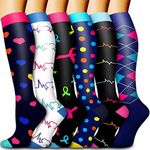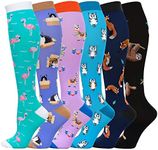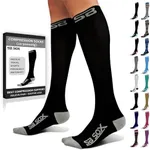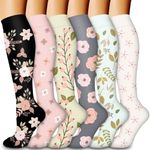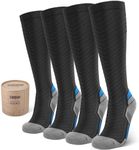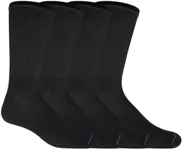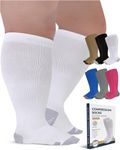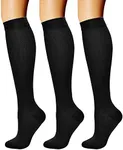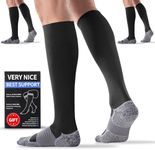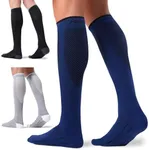Buying Guide for the Best Compression Socks For Elderly
Compression socks are a great way to improve circulation, reduce swelling, and provide support for the legs, especially for the elderly. When choosing the right pair of compression socks, it's important to consider several key specifications to ensure they meet the specific needs of the user. Here are some important factors to consider when selecting compression socks for the elderly.Compression LevelCompression level refers to the amount of pressure the socks apply to your legs, measured in millimeters of mercury (mmHg). This is important because different levels of compression are suitable for different conditions. Light compression (8-15 mmHg) is good for general comfort and minor swelling. Moderate compression (15-20 mmHg) is often used for mild varicose veins and minor swelling. Firm compression (20-30 mmHg) is typically recommended for more severe varicose veins, moderate swelling, and post-surgical recovery. Extra-firm compression (30-40 mmHg) is used for severe swelling and serious medical conditions. To pick the right one, consider the specific health needs and consult with a healthcare provider if necessary.
MaterialThe material of the compression socks affects comfort, breathability, and durability. Common materials include nylon, spandex, and cotton blends. Nylon and spandex provide good elasticity and durability, making them suitable for everyday wear. Cotton blends are softer and more breathable, which can be more comfortable for sensitive skin. For the elderly, it's important to choose a material that is comfortable for long-term wear and does not cause irritation.
Size and FitProper sizing is crucial for the effectiveness and comfort of compression socks. Sizes are usually based on measurements of the ankle, calf, and sometimes the thigh. A well-fitted sock should provide consistent compression without being too tight or too loose. To find the right size, measure the leg at the points specified by the manufacturer and refer to their sizing chart. For the elderly, ensure the socks are easy to put on and take off, and consider options with zippers or adjustable features if dexterity is an issue.
LengthCompression socks come in various lengths, including knee-high, thigh-high, and full-length (pantyhose). The length you choose depends on where the compression is needed. Knee-high socks are suitable for most conditions affecting the lower legs, such as varicose veins and swelling. Thigh-high and full-length options provide additional support for issues that extend above the knee. For the elderly, knee-high socks are often the most practical and easiest to manage.
Ease of UseEase of use is an important consideration, especially for the elderly who may have limited mobility or dexterity. Look for features like easy-to-grip tops, zippers, or Velcro closures that make the socks easier to put on and take off. Some compression socks are designed with a more flexible material that stretches more easily, which can also help. Choosing socks that are easy to use will encourage regular wear and ensure the user gets the full benefits of compression therapy.
DurabilityDurability refers to how well the socks hold up over time with regular use and washing. High-quality compression socks should maintain their elasticity and compression level even after multiple washes. Look for socks with reinforced toes and heels, as these areas tend to wear out the fastest. For the elderly, durable socks mean fewer replacements and consistent support, making them a more practical and cost-effective choice in the long run.
